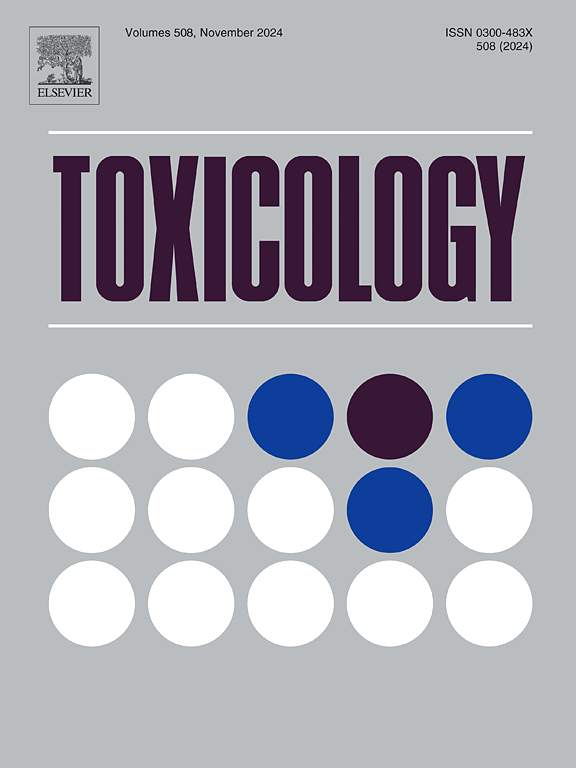使用新方法鉴定植物保护产品中的增敏共配方剂。
IF 4.8
3区 医学
Q1 PHARMACOLOGY & PHARMACY
引用次数: 0
摘要
根据法规(EC) No 1272/2008,植物保护产品(PPPs)可以根据皮肤致敏性进行分类,既可以考虑整个配方,也可以考虑单个成分。对于一小部分ppp,两种评估策略的应用会导致不同的分类结果。我们在此旨在解决PPP 1的这种差异,PPP 1是一种示例性产品,通过局部淋巴结检测阳性被归类为致敏,但通过基于成分的方法评分为阴性。根据该法规的建议,我们根据新方法方法(NAMs)的组合收集了进一步的数据,这些方法方法(NAMs)涵盖了皮肤致敏不良结果通路模型中的几个关键事件(KEs)。准确地说,我们采用了定量结构活性关系(QSAR)分析(KE 1),人细胞系激活试验(h-CLAT),辅以白细胞介素-8释放测量(KE 3)和一种新的短期T细胞试验,该试验基于激活标记物的诱导表达(KE 4)。我们测试了完整的产品,单个共制剂(cf)或单一物质。PPP 1在所有体外试验中均呈阳性。QSAR分析显示两种CFs含有致敏化学物质。在最小诱导阈值为1.5mg/mL时,只有cf1在h-CLAT中检测出阳性,其效力低于PPP 1。在T细胞试验中,PPP 1和CF 1在0.1mg/mL左右均呈阳性。总之,我们的研究结果提出了一种新的基于nama的综合策略,应该进一步探索复杂混合物(如ppp)的皮肤致敏危害识别。最多245字。250)。本文章由计算机程序翻译,如有差异,请以英文原文为准。
Using new approach methodologies for the identification of a sensitizing co-formulant in a plant protection product
According to Regulation (EC) No 1272/2008, plant protection products (PPPs) can be classified for skin sensitisation by either considering the full formulation or the individual components. For a fraction of PPPs, an application of both assessment strategies results in discrepant classification results. We here aimed to resolve this discrepancy for PPP 1, an exemplary product, which was classified as sensitizing by a positive local lymph node assay but scored negative by the component-based method. We collected further data, as suggested by the regulation, based on a combination of new approach methodologies (NAMs) covering several key events (KEs) in the adverse outcome pathway model for skin sensitisation. Precisely, we employed quantitative structure activity relationship (QSAR) analysis (KE 1), the human cell line activation test (h-CLAT) complemented by Interleukin-8 release measurements (KE 3) and a novel short-term T cell test that is based on the induced expression of activation markers (KE 4). We tested the complete product, individual co-formulants (CFs) or single substances. PPP 1 tested positive in all in vitro assays. QSAR analysis revealed two CFs containing sensitizing chemicals. Only CF 1 was tested positive in the h-CLAT at a minimal induction threshold of 1.5 mg/mL, being less potent than PPP 1. In the T cell assay, both PPP 1 and CF 1 were tested positive at around 0.1 mg/mL. In conclusion, our results propose a novel integrated NAM-based strategy that should be explored further for skin sensitisation hazard identification of complex mixtures, such as PPPs.
求助全文
通过发布文献求助,成功后即可免费获取论文全文。
去求助
来源期刊

Toxicology
医学-毒理学
CiteScore
7.80
自引率
4.40%
发文量
222
审稿时长
23 days
期刊介绍:
Toxicology is an international, peer-reviewed journal that publishes only the highest quality original scientific research and critical reviews describing hypothesis-based investigations into mechanisms of toxicity associated with exposures to xenobiotic chemicals, particularly as it relates to human health. In this respect "mechanisms" is defined on both the macro (e.g. physiological, biological, kinetic, species, sex, etc.) and molecular (genomic, transcriptomic, metabolic, etc.) scale. Emphasis is placed on findings that identify novel hazards and that can be extrapolated to exposures and mechanisms that are relevant to estimating human risk. Toxicology also publishes brief communications, personal commentaries and opinion articles, as well as concise expert reviews on contemporary topics. All research and review articles published in Toxicology are subject to rigorous peer review. Authors are asked to contact the Editor-in-Chief prior to submitting review articles or commentaries for consideration for publication in Toxicology.
 求助内容:
求助内容: 应助结果提醒方式:
应助结果提醒方式:


